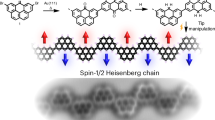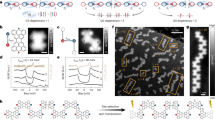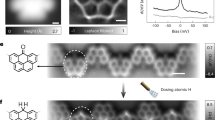Abstract
Graphene nanostructures with π magnetism offer a chemically tunable platform to explore quantum magnetic interactions. However, the realization of nanographene-based chains bearing controlled spin order is highly challenging due to the limited availability of building blocks and the lack of efficient polymerization strategies for chain growth. Here, we demonstrate the successful on-surface synthesis of spin-1/2 antiferromagnetic Heisenberg chains with parity-dependent magnetization based on antiaromatic diaza-hexa-peri-hexabenzocoronene (diaza-HBC) units. Using distinct synthetic strategies, two types of spin chain with different terminals are synthesized, both exhibiting a robust odd–even effect on the spin coupling along the chain. Combined investigations using scanning tunnelling microscopy, non-contact atomic force microscopy, density functional theory calculations and quantum spin models confirm the structures of the diaza-HBC chains and elucidate their magnetic properties, which have an S = 1/2 spin per unit through electron donation from the diaza-HBC core to the Au(111) substrate. Gapped excitations are observed in even-numbered chains, while enhanced Kondo resonance emerges in odd-numbered units of odd-numbered chains due to the redistribution of the unpaired spin along the chain. Our findings provide an effective strategy to construct inaccessible nanographene-based spin chains and unveil the odd–even effect in their magnetic properties, offering potential applications in nanoscale spintronics.

This is a preview of subscription content, access via your institution
Access options
Subscribe to this journal
Receive 12 digital issues and online access to articles
$119.00 per year
only $9.92 per issue
Buy this article
- Purchase on SpringerLink
- Instant access to full article PDF
Prices may be subject to local taxes which are calculated during checkout




Similar content being viewed by others
Data availability
The authors declare that the data supporting the findings of this study are available within the paper and its Supplementary Information files. The data that support the findings of this study are also available from the corresponding authors upon request.
References
Fernández-Rossier, J. & Palacios, J. J. Magnetism in graphene nanoislands. Phys. Rev. Lett. 99, 177204 (2007).
Han, W., Kawakami, R. K., Gmitra, M. & Fabian, J. Graphene spintronics. Nat. Nanotech. 9, 794–807 (2014).
Yazyev, O. V. & Katsnelson, M. I. Magnetic correlations at graphene edges: basis for novel spintronics devices. Phys. Rev. Lett. 100, 047209 (2008).
Wang, H. et al. Graphene nanoribbons for quantum electronics. Nat. Rev. Phys. 3, 791–802 (2021).
Candini, A., Klyatskaya, S., Ruben, M., Wernsdorfer, W. & Affronte, M. Graphene spintronic devices with molecular nanomagnets. Nano Lett. 11, 2634–2639 (2011).
Rocha, A. R. et al. Towards molecular spintronics. Nat. Mater. 4, 335–339 (2005).
Pesin, D. & MacDonald, A. H. Spintronics and pseudospintronics in graphene and topological insulators. Nat. Mater. 11, 409–416 (2012).
Zheng, Y. et al. Engineering of magnetic coupling in nanographene. Phys. Rev. Lett. 124, 147206 (2020).
Zheng, Y. et al. Designer spin order in diradical nanographenes. Nat. Commun. 11, 6076 (2020).
Li, J. et al. Uncovering the triplet ground state of triangular graphene nanoflakes engineered with atomic precision on a metal surface. Phys. Rev. Lett. 124, 177201 (2020).
Li, J. et al. Single spin localization and manipulation in graphene open-shell nanostructures. Nat. Commun. 10, 200 (2019).
Mishra, S. et al. Topological frustration induces unconventional magnetism in a nanographene. Nat. Nanotech. 15, 22–28 (2020).
Ruffieux, P. et al. On-surface synthesis of graphene nanoribbons with zigzag edge topology. Nature 531, 489–492 (2016).
Mishra, S. et al. Collective all-carbon magnetism in triangulene dimers. Angew. Chem. Int. Ed. 59, 12041–12047 (2020).
Mishra, S. et al. Large magnetic exchange coupling in rhombus-shaped nanographenes with zigzag periphery. Nat. Chem. 13, 581–586 (2021).
Pavliček, N. et al. Synthesis and characterization of triangulene. Nat. Nanotech. 12, 308–311 (2017).
Blackwell, R. E. et al. Spin splitting of dopant edge state in magnetic zigzag graphene nanoribbons. Nature 600, 647–652 (2021).
Du, Q. et al. Orbital-symmetry effects on magnetic exchange in open-shell nanographenes. Nat. Commun. 14, 4802 (2023).
Song, S. et al. Highly entangled polyradical nanographene with coexisting strong correlation and topological frustration. Nat. Chem. 16, 938–944 (2024).
Chang, X. et al. On-surface synthesis and edge states of NBN-doped zigzag graphene nanoribbons. Nano Res. 16, 10436–10442 (2023).
Mishra, S. et al. Synthesis and characterization of π-extended triangulene. J. Am. Chem. Soc. 141, 10621–10625 (2019).
Sun, Q. et al. Coupled spin states in armchair graphene nanoribbons with asymmetric zigzag edge extensions. Nano Lett. 20, 6429–6436 (2020).
McCurdy, R. D. et al. Engineering robust metallic zero-mode states in olympicene graphene nanoribbons. J. Am. Chem. Soc. 145, 15162–15170 (2023).
Yazyev, O. V. Emergence of magnetism in graphene materials and nanostructures. Rep. Prog. Phys. 73, 056501 (2010).
Wang, W. L., Yazyev, O. V., Meng, S. & Kaxiras, E. Topological frustration in graphene nanoflakes: magnetic order and spin logic devices. Phys. Rev. Lett. 102, 157201 (2009).
Ortiz, R. et al. Exchange rules for diradical π-conjugated hydrocarbons. Nano Lett. 19, 5991–5997 (2019).
Haldane, F. D. M. Nonlinear field theory of large-spin Heisenberg antiferromagnets: semiclassically quantized solitons of the one-dimensional Easy-Axis Néel state. Phys. Rev. Lett. 50, 1153–1156 (1983).
Haldane, F. D. M. Continuum dynamics of the 1-D Heisenberg antiferromagnet: identification with the O(3) nonlinear sigma model. Phys. Lett. A 93, 464–468 (1983).
Hagiwara, M., Katsumata, K., Affleck, I., Halperin, B. I. & Renard, J. P. Observation of S = 1/2 degrees of freedom in an S = 1 linear-chain Heisenberg antiferromagnet. Phys. Rev. Lett. 65, 3181–3184 (1990).
Miyashita, S. & Yamamoto, S. Effects of edges in S = 1 Heisenberg antiferromagnetic chains. Phys. Rev. B 48, 913–919 (1993).
Lounis, S., Dederichs, P. H. & Blügel, S. Magnetism of nanowires driven by novel even-odd effects. Phys. Rev. Lett. 101, 107204 (2008).
Machens, A., Konstantinidis, N. P., Waldmann, O., Schneider, I. & Eggert, S. Even-odd effect in short antiferromagnetic Heisenberg chains. Phys. Rev. B 87, 144409 (2013).
Politi, P. & Pini, M. G. Even-odd effects in finite Heisenberg spin chains. Phys. Rev. B 79, 012405 (2009).
Mishra, S. et al. Observation of fractional edge excitations in nanographene spin chains. Nature 598, 287–292 (2021).
Zhao, Y. et al. Quantum nanomagnets in on-surface metal-free porphyrin chains. Nat. Chem. 15, 53–60 (2023).
Friedenauer, A., Schmitz, H., Glueckert, J. T., Porras, D. & Schaetz, T. Simulating a quantum magnet with trapped ions. Nat. Phys. 4, 757–761 (2008).
Kim, K. et al. Quantum simulation of frustrated Ising spins with trapped ions. Nature 465, 590–593 (2010).
Sun K. et al. Heisenberg spin-1/2 antiferromagnetic molecular chains. Preprint at https://arxiv.org/abs/2407.02142 (2024).
Su X. et al. Fabrication of spin-1/2 Heisenberg antiferromagnetic chains via combined on-surface synthesis and reduction for spinon detection. Preprint at https://arxiv.org/abs/2408.08801 (2024).
Yuan Z. et al. Fractional spinon quasiparticles in open-shell triangulene spin-1/2 chains. J. Am. Chem. Soc. https://doi.org/10.1021/jacs.4c14712 (2025).
Zhao C. et al. Gapless spin excitations in nanographene-based antiferromagnetic spin-½ Heisenberg chains. Preprint at https://arxiv.org/abs/2408.10045 (2024).
Wang, X. Y. et al. Exploration of pyrazine-embedded antiaromatic polycyclic hydrocarbons generated by solution and on-surface azomethine ylide homocoupling. Nat. Commun. 8, 1948 (2017).
Kawai, S. et al. Multiple heteroatom substitution to graphene nanoribbon. Sci. Adv. 4, eaar7181 (2018).
Mohn, F., Gross, L., Moll, N. & Meyer, G. Imaging the charge distribution within a single molecule. Nat. Nanotech. 7, 227–231 (2012).
Gross, L. et al. Measuring the charge state of an adatom with noncontact atomic force microscopy. Science 324, 1428–1431 (2009).
Fernández-Rossier, J. Theory of single-spin inelastic tunneling spectroscopy. Phys. Rev. Lett. 102, 256802 (2009).
Spinelli, A., Bryant, B., Delgado, F., Fernández-Rossier, J. & Otte, A. F. Imaging of spin waves in atomically designed nanomagnets. Nat. Mater. 13, 782–785 (2014).
Ternes, M. Spin excitations and correlations in scanning tunneling spectroscopy. New J. Phys. 17, 063016 (2015).
Lieb, E., Schultz, T. & Mattis, D. Two soluble models of an antiferromagnetic chain. Ann. Phys. 16, 407–466 (1961).
Giessibl, F. J. The qPlus sensor, a powerful core for the atomic force microscope. Rev. Sci. Instrum. 90, 011101 (2019).
Gross, L., Mohn, F., Moll, N., Liljeroth, P. & Meyer, G. The chemical structure of a molecule resolved by atomic force microscopy. Science 325, 1110–1114 (2009).
Bartels, L., Meyer, G. & Rieder, K.-H. Controlled vertical manipulation of single CO molecules with the scanning tunneling microscope: a route to chemical contrast. Appl. Phys. Lett. 71, 213–215 (1997).
Kresse, G. & Furthmüller, J. Efficient iterative schemes for ab initio total-energy calculations using a plane-wave basis set. Phys. Rev. B 54, 11169–11186 (1996).
Blochl, P. E. Projector augmented-wave method. Phys. Rev. B 50, 17953–17979 (1994).
Kresse, G. & Joubert, D. From ultrasoft pseudopotentials to the projector augmented-wave method. Phys. Rev. B 59, 1758–1775 (1999).
Dion, M., Rydberg, H., Schröder, E., Langreth, D. C. & Lundqvist, B. I. Van der Waals density functional for general geometries. Phys. Rev. Lett. 92, 246401 (2004).
Klimeš, J., Bowler, D. R. & Michaelides, A. Chemical accuracy for the van der Waals density functional. J. Phys. Condens. Matter 22, 022201 (2009).
Klimeš, J., Bowler, D. R. & Michaelides, A. Van der Waals density functionals applied to solids. Phys. Rev. B 83, 195131 (2011).
Acknowledgements
We thank Z. Wang (Boston College) and F. Liu (University of Utah) for the helpful discussions. L.H. and J.M. acknowledge the financial support from the National Natural Science Foundation of China (grant no. 92463307); H.-J.G. acknowledges the financial support from the National Natural Science Foundation of China (grant no. 62488201); H.-J.G., L.H. and H.C. acknowledge the Innovation Program of Quantum Science and Technology (grant no. 2021ZD0302700); S.D. acknowledges the National Key Research and Development Program of China (grant no. 2022YFA1204100); X. Feng and J.M. acknowledge the EU Graphene Flagship (Graphene Core 3, grant no. 881603), the Center for Advancing Electronics Dresden (cfaed), H2020-EU.1.2.2.—FET Proactive grant (LIGHT-CAP, grant no. 101017821) and EIC-2022-Pathfinder Open (ATYPIQUAL, grant no. 101099098); J.F.-R. and J.C.G.H. acknowledge the Portuguese Foundation for Science and Technology (FCT) (grant no. PTDC/FIS-MAC/2045/2021), SNF Sinergia (Grant Pimag) and the HE grant no. FUNLAYERS-101079184; J.F.-R. acknowledges funding from Generalitat Valenciana funding Prometeo2021/017 and grant no. MFA/2022/045, and funding from MICIIN-Spain (grant no. PID2019-109539GB-C41); X.L., L.H. and H.C. acknowledge the Chinese Academy of Sciences (CAS) Project for Young Scientists in Basic Research (grant nos. YSBR-003 and YSBR-053); Y.G. acknowledges the financial support from the National Natural Science Foundation of China (grant no. 52350322).
Author information
Authors and Affiliations
Contributions
H.-J.G. and X. Feng supervised the project. L.H., J.M. and. C.-A.P. conceived the experiment. X. Fu, L.H., X.H., H.C., Y.W., Z.C. and X.L. performed STM/AFM experiments with the guidance of H.-J.G. K.L. synthesized and characterized the precursor molecules under the supervision of J.M. and X. Feng. J.C.G.H. performed theoretical calculations supervised by J.F.-R. Y.G. carried out DFT calculations with the guidance of S.D. L.H., J.M., J.F-.R., X. Feng and H.-J.G. wrote the manuscript with inputs from all authors. X. Fu, L.H. and K.L. contributed equally to this work.
Corresponding authors
Ethics declarations
Competing interests
The authors declare no competing interests.
Peer review
Peer review information
Nature Synthesis thanks Jiong Lu, Shiyong Wang and the other, anonymous, reviewer(s) for their contribution to the peer review of this work. Primary Handling Editor: Peter Seavill, in collaboration with the Nature Synthesis team.
Additional information
Publisher’s note Springer Nature remains neutral with regard to jurisdictional claims in published maps and institutional affiliations.
Supplementary information
Supplementary Information
Experimental Details, Figs. 1–18 and Schemes 1 and 2.
Supplementary Data 1
The source data for Supplementary Fig. 7.
Supplementary Data 2
The source data for Supplementary Fig. 8.
Supplementary Data 3
The source data for Supplementary Fig. 9.
Supplementary Data 4
The source data for Supplementary Fig. 10.
Supplementary Data 5
The source data for Supplementary Fig. 11.
Supplementary Data 6
The source data for Supplementary Fig. 12.
Supplementary Data 7
The source data for Supplementary Fig. 13.
Supplementary Data 8
The source data for Supplementary Fig. 14.
Supplementary Data 9
The source data for Supplementary Fig. 15.
Supplementary Data 10
The source data for Supplementary Fig. 16.
Supplementary Data 11
The source data for Supplementary Fig. 17.
Supplementary Data 12
The source data for Supplementary Fig. 18.
Source data
Source Data Fig. 1
Statistical source data, dI/dV spectra, PODOS, charge transfer source data and the images.
Source Data Fig. 2
Source images in the figure.
Source Data Fig. 3
dI/dV spectra, theoretical calculations source data and the images.
Source Data Fig. 4
dI/dV spectra, theoretical calculations source data and the images.
Rights and permissions
Springer Nature or its licensor (e.g. a society or other partner) holds exclusive rights to this article under a publishing agreement with the author(s) or other rightsholder(s); author self-archiving of the accepted manuscript version of this article is solely governed by the terms of such publishing agreement and applicable law.
About this article
Cite this article
Fu, X., Huang, L., Liu, K. et al. Building spin-1/2 antiferromagnetic Heisenberg chains with diaza-nanographenes. Nat. Synth 4, 684–693 (2025). https://doi.org/10.1038/s44160-025-00743-5
Received:
Accepted:
Published:
Issue date:
DOI: https://doi.org/10.1038/s44160-025-00743-5
This article is cited by
-
Spin-1/2 Heisenberg chains realized in π-electron systems
Nature Synthesis (2025)
-
Spins in chains
Nature Materials (2025)



